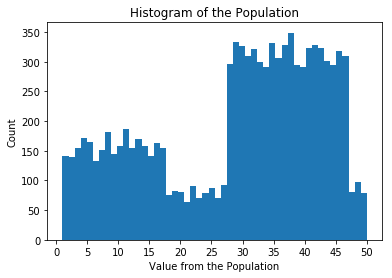中心極限定理
從這里開始直到高斯分布課程結尾的內容皆為選修部分。
這一部分介紹了高斯分布的由來。如果你想深入學習高斯分布背后的理論,那么請繼續。如果你不想,也可以直接跳到機器人定位課程。
總體
總體中包含了數據集中的所有值。在這一課中,我們將用到的數據就像下面這樣:

Population Distribution
例如,值 15 在總體中大概出現了 160 次,值 50 在總體中大概出現了 70 次。這個總體中一共有 10,000 個數據點。
隨機從這一分布中抽取 100 個數據點,並將這 100 個數據點稱為一個樣本。接着計算該樣本的均值。如果你照此方法反復抽取樣本,得到的均值將呈高斯分布。
隨着大量樣本均值的計算,看着人口分布逐漸向高斯分布靠近,這是一件十分神奇的事。
在本課程的下一部分,我們將為你呈現如何使用 Python 代碼做到這一點。
在本節中,我們將向你介紹如何運用中心極限定理。我們將:
- 從總體中生成隨機樣本
- 獲取樣本均值
- 將結果均值可視化
你會看到,雖然總體不遵循高斯分布,但樣本均值的結果分布確實看起來符合高斯分布。
要開始整個任務,請運行下面的代碼單元格。這個單元格將通過運行一個輔助函數來創建總體數據,然后將總體數據可視化,並計算總體數據的平均值。總人口中有10,000個數據點。
如果多次運行該單元格,你會發現分布稍有變化;但是,總體形狀保持不變。
import helpers
import numpy as np
%matplotlib inline
population_data = helpers.distribution(50, 10000, 100)
helpers.histogram_visualization(population_data)
print('population mean ', np.mean(population_data))

從人口中抽樣
下一個代碼單元格將隨機從總體中選擇N個數據點。這N個數據點將被稱為樣本。我們使用numpy庫的random.choice方法隨機選擇N個值,你可以在 這里 讀取這些值。
運行下面的代碼單元格,查看一些示例輸出。該代碼從總體中隨機抽取10個數據點,制作一個大小為10的樣本。
def random_sample(population_data, sample_size):
return np.random.choice(population_data, size = sample_size)
random_sample(population_data, 10)
array([33, 40, 29, 13, 48, 7, 41, 11, 32, 1])
計算樣本均值
接下來我們將使用numpy庫來計算每個隨機生成的樣本的平均值。
def sample_mean(sample):
return np.mean(sample)
# take a sample from the population
example_sample = random_sample(population_data, 10)
# calculate the mean of the sample and output the results
sample_mean(example_sample)
29.300000000000001
中心極限定理結果
現在,我們將使用random_sample()函數和sample_mean()函數來演示中心極限定理是如何運用的。
下面的代碼包含一個for循環,該循環會制作一個大小為N的隨機樣本,然后取樣本的均值,並將該均值存儲在列表中。 for循環的每次迭代都會有一個不同的隨機樣本。研究下面的代碼,然后運行該單元格。
###
# Code for showing how the central limit theorem works.
# The function inputs:
# population - population data
# n - sample size
# iterations - number of times to draw random samples
def central_limit_theorem(population, n, iterations):
sample_means_results = []
for i in range(iterations):
# get a random sample from the population of size n
sample = random_sample(population, n)
# calculate the mean of the random sample
# and append the mean to the results list
sample_means_results.append(sample_mean(sample))
return sample_means_results
print('Means of all the samples ')
central_limit_theorem(population_data, 10, 10000)
[25.600000000000001, 22.800000000000001, 30.0, 28.899999999999999, 32.200000000000003, 29.399999999999999, 32.0, 35.299999999999997, 25.600000000000001,
35.5, 31.300000000000001, 24.5, 28.300000000000001, 23.300000000000001, ...]
將結果可視化 —— 樣本容量= 30
下一個單元格將計算每個大小為30的一萬個樣本的均值,然后使用直方圖將樣本均值可視化。需要注意的是,這個可視化結果大致與高斯分布類似。
import matplotlib.pyplot as plt
def visualize_results(sample_means):
plt.hist(sample_means, bins = 30)
plt.title('Histogram of the Sample Means')
plt.xlabel('Mean Value')
plt.ylabel('Count')
# Take random sample and calculate the means
sample_means_results = central_limit_theorem(population_data, 30, 10000)
# Visualize the results
visualize_results(sample_means_results)

所以我們剛開始使用的人口樣本肯定不符合高斯分布。但是,通過對分布樣本進行抽樣並計算樣本均值,我們最終會看到一些看起來像高斯分布的東西。
將結果可視化 —— 樣本容量= 1
根據中心極限定理,樣本容量需要足夠大。一般的經驗法則是樣本容量應該大於或等於30。讓我們嘗試使用不同的樣本容量來查看會有什么不同的結果。
一個比較誇張的情況是樣本容量為1。它的分布應該與原始人口的分布類似。運行下面的代碼,查看結果。
# Take random sample and calculate the means sample_means_results = central_limit_theorem(population_data, 1, 10000) # Visualize the results visualize_results(sample_means_results)

將結果可視化 ——樣本容量= 10
現在,我們使用建議的最小樣本容量,即30,看看會發生什么。
# Take random sample and calculate the means sample_means_results = central_limit_theorem(population_data, 10, 10000) # Visualize the results visualize_results(sample_means_results)

樣本容量為10時,樣本均值的分布看起來類似高斯分布。
將結果可視化 —— 樣本容量= 1000
讓我們繼續嘗試,並使用更大的樣本容量:這次為1000。
# Take random sample and calculate the means sample_means_results = central_limit_theorem(population_data, 1000, 10000) # Visualize the results visualize_results(sample_means_results)

將結果可視化 —— 樣本容量= 10000
如果樣本容量等於人口數量,會發生什么情況?因為我們隨機抽樣進行替換,所以其中一個樣本不太可能是完全的人口數據;然而,由於每個樣本可能與人口相似,因此標准差應該進一步降低。
# Take random sample and calculate the means sample_means_results = central_limit_theorem(population_data, 10000, 10000) # Visualize the results visualize_results(sample_means_results)

結論
我們還要注意,這些分布的中心接近原始人口均值。
想一想是否要收集現實世界中的數據。如果你想找到世界各地人口的身高分布,你可以測量每個人的身高並分析結果。如果使用該結果的均值,那么你將獲得真實的人體高度平均值;然而,要使用這個辦法去衡量整個世界人口是不可行的。
相反,你可以使用身高的一個樣本。如果只測量了三十人,你的抽樣均值可能會與人口平均值相差較大。但是,如果測量了20億個隨機選擇的人,那么樣本均值可能更接近人口均值。你的樣本越大,樣本均值就越可能與真實的人口均值相匹配。
